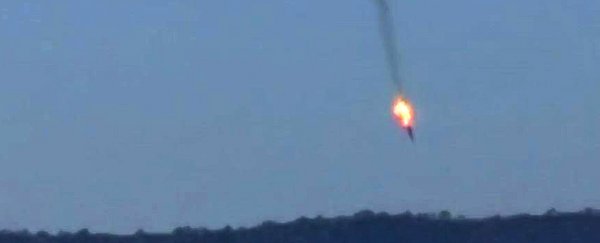Last week, a Russian military plane was shot down near the border of Turkey, after Turkish authorities claim it violated their airspace for 17 seconds without permission, and ignored 10 warnings to turn back in the space of 5 minutes.
Russian authorities have since dismissed those claims as "rubbish" and argue that the plane was actually shot down over Syrian airspace. But now two Belgian astrophysicists have cast doubt on both countries' stories, showing that the physics of the crash don't match either claim.
Writing in the Katholieke Universiteit Leuven (KU Leuven) blog, Tom Van Doorsselaere and Giovanni Lapenta explain that after reviewing the video footage of the plane being shot down, and analysing the distance between where it was reportedly shot and where it crashed, they've calculated that the plane was going faster than Turkey says it was.
According to Turkish officials, the jet was around 2 km inside Turkish airspace before it was shot down, and it crashed 8 km away in northern Syria. From those numbers, the physicists calculated that the jet would have been travelling at a speed of around 960 km/h – the standard veloicty for this type of plane.
But based on those calculations, the plane would have only been in Turkish air space for 7 seconds – not 17, as the Turkish military has claimed.
The physicists also cast some doubt on the 10 warnings that were reportedly issued in the space of 5 minutes, because if the jet was travelling at a speed of 960 km/h, it wouldn't have been anywhere near Turkish airspace that far out.
"How could the Turkish airforce predict that the Russian jets were about to enter Turkish airspace?" write Van Doorsselaere and Lapenta.
"Military jets are very agile, and in theory the Russian jets could have turned at the last moment to avoid Turkish airspace. The warnings issued to the Russian pilots were mere speculation at the moment they were made," they add.
But the Turkish story isn't the only one that doesn't make sense, according to the scientists. Russian authorities have claimed that the jet made a 90-degree turn after being hit in an attempt to actively try to avoid Turkish airspace.
This would make sense if a different aircraft was involved, but based on the weight of the model, and the speed at which it was travelling, that kind of turn just wouldn't be possible, say Van Doorsselaere and Lapenta.
"A change of course of 90 degrees can only be achieved with an object that's many times heavier or faster than the jet," they explain.
Before you get too excited, we can't take as much from this research as you might like, because it's yet to be peer-reviewed. That means the physicists could have made mistakes in their calculations, or might not have considered all the information before drawing their conclusions.
But so far the evidence does suggest that neither country is being entirely honest about what happened, and it seems likely that there's more to the story, at least from a scientific point of view, if nothing else.
"According to our calculations, it is clear that both the story of Turkey and Russia should be taken with a grain of salt," conclude the researchers. "Estimates limit the violation of Turkish airspace to a maximum of 10s. Russia's claim … does not correspond to the laws of mechanics."
